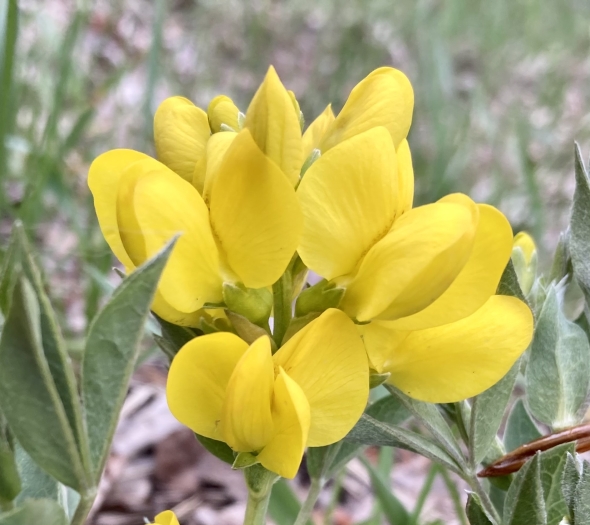Prairie Thermopsis
(Thermopsis rhombifolia)
Prairie Thermopsis (Thermopsis rhombifolia)
/
/

Caleb Catto
CC BY 4.0
Image By:
Caleb Catto
Recorded By:
Copyright:
CC BY 4.0
Copyright Notice:
Photo by: Caleb Catto | License Type: CC BY 4.0 | License URL: http://creativecommons.org/licenses/by/4.0/ | Rights Holder: Caleb Catto | Publisher: iNaturalist | Date Created: 2021-05-19T00:45:41Z |










































































Estimated Native Range
Summary
Thermopsis rhombifolia, commonly known as Prairie Thermopsis, is a perennial herb that is deciduous or semi-deciduous, native to open grasslands and meadows in the Western United States and Canada. It typically grows to a height of 1-3 feet (0.3-0.9 meters) and a width of 0.3-0.8 feet (0.09-0.2 meters). The plant has a clumping form with upright stems and trifoliate leaves, resembling those of a lupine. It produces bright yellow, pea-like flowers in the spring, which are arranged in dense, elongated clusters and are quite showy, attracting pollinators such as bees and butterflies.
Prairie Thermopsis is valued for its vibrant yellow blooms and its ability to adapt to a variety of garden settings. It is often used in wildflower meadows, perennial borders, and as a filler in mixed beds due to its upright growth habit. This plant is relatively low maintenance, requiring minimal care once established. It prefers full sun to part shade and thrives in well-drained soils. While it tolerates drought, moderate watering will keep it looking its best. Prairie Thermopsis is not commonly affected by serious pests or diseases, but it can be susceptible to root rot if grown in poorly drained soils. It is not known to be invasive and does not have aggressive roots, making it a safe choice for most garden settings.CC BY-SA 4.0
Prairie Thermopsis is valued for its vibrant yellow blooms and its ability to adapt to a variety of garden settings. It is often used in wildflower meadows, perennial borders, and as a filler in mixed beds due to its upright growth habit. This plant is relatively low maintenance, requiring minimal care once established. It prefers full sun to part shade and thrives in well-drained soils. While it tolerates drought, moderate watering will keep it looking its best. Prairie Thermopsis is not commonly affected by serious pests or diseases, but it can be susceptible to root rot if grown in poorly drained soils. It is not known to be invasive and does not have aggressive roots, making it a safe choice for most garden settings.CC BY-SA 4.0
Plant Description
- Plant Type: Herb
- Height: 1-3 feet
- Width: 0.3-0.8 feet
- Growth Rate: Moderate
- Flower Color: Yellow
- Flowering Season: Spring
- Leaf Retention: Deciduous
Growth Requirements
- Sun: Full Sun, Part Shade
- Water: Medium
- Drainage: Fast
Common Uses
Bee Garden, Butterfly Garden, Low Maintenance, Showy Flowers
Natural Habitat
Native to open grasslands and meadows in the Western United States and Canada
Other Names
Common Names: Circle-Pod-Pea, Goldenpea
Scientific Names: , Thermopsis rhombifolia, Cytisus rhombifolius, Drepilia rhombifolia, Scolobus rhombifolius, Thermia rhombifolia, Thermopsis pauciflora,
GBIF Accepted Name: Thermopsis rhombifolia (Pursh) Richardson